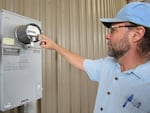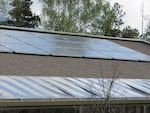
Ashland Conservation Analyst Larry Giardina checks the energy production of Solar Pioneer II.
Jes Burns, OPB/EarthFix
When the most recent legislative session ended in Oregon, the state's energy future looked very different than it had just a few months earlier. Lawmakers moved to get Oregon off of coal by 2030. And that means replacing one-third of the state's power supply in just 14 years.
Renewable energy development will likely benefit – and in particular, Oregon’s new laws are setting up solar as a potential big winner.
Here are answers to some big questions about solar development in Oregon:
What does the solar landscape look like right now?
Think about it as if there are three fingers of solar development pushing ahead right now in Oregon. There’s residential solar – think panels on houses paid for by the homeowner. Then there are much larger commercial or industrial arrays generating energy for power companies. And finally there’s community solar, sometimes called shared solar. This usually takes the form of larger scale solar arrays that individuals can buy shares in – kind of like an solar co-op where you own the energy produced by your share. All of these have been chugging along in Oregon at different rates.
What has been the most successful?
It’s a bit difficult to quantify. The Oregon Department of Energy (ODE) says it doesn’t have good data about how many and where solar is going in in the state. Projects are permitted locally. And unless there’s a state subsidy involved, then approvals don’t go through ODE.
Oregon has the best, or at least close to the best, residential solar subsidies in the country. The systems now pay for themselves in 4-7 years and are money-makers after that. So residential solar development has happened at a pretty quick clip.
But now that Oregon is moving decisively away from coal, renewable energy development really has to step up to help make up the difference. For solar to be part of this, a there will have to be larger scale projects.
“I think it's just going to continue to increase. Especially in certain areas of the state where you're going to have large installations, maybe some utility-scale solar. And then as people become more keen to the environment and more keen to the benefits of solar. I think it's an important contributor, and will be an important contributor to the state of Oregon." — Michael Dougherty, COO, Oregon Public Utility Commission.”
But right now, ODE says solar only accounts for one-tenth of 1 percent of Oregon’s energy mix. There’s a long way to go.
So how’s that going to happen?
In March, Gov. Kate Brown signed a law (House Bill 4037) that offers a half-cent per kilowatt-hour incentive to large-scale solar. It should help these projects pencil out for developers. Eastern and southern Oregon, where the electricity-producing quality of the sun is best, are the areas most likely see projects popping up.
But community solar is the other piece of this?
It will have a role to play, yes.
Solar Pioneer II in Ashland is one of the oldest community solar projects in the state.

Tracking yearly solar energy production of one of the oldest community solar projects in Oregon.
Jes Burns, OPB/EarthFix
“That’s 363 panels. That’s installed on the city service center’s covered parking structure, says Larry Giardina, Ashland’s conservation analyst.
About a decade ago, Ashland was an early adopter of community solar. It was an idea that really captured Giardina’s imagination — a way to get renters and people with shady roofs involved in solar by buying subscriptions. Eight years in, the system is still working well.
“Last year was an even better year than the first one,” Giardina says about the electricity produced in 2015.
But the problem with being an early adopter is that you’re kind of feeling around in the dark. And it turned out that the city was only able to sell about half their subscriptions before the technology got better and cheaper and subsidies improved. Suddenly Pioneer II wasn’t a good deal any more. So people stopped buying shares.
What Giardina and Solar Pioneer II helped do for Oregon is help make the road less bumpy for others pushing their own projects.
“I think you think outside the box and consider everything. You don't want to suffer unintended consequences, but you also don't want to be limited by what's been done before." -Larry Giardina, conservation analyst, City of Ashland”
Is community solar catching on?
Slowly, yes. For example, in January Central Electric Cooperative in Redmond brought the largest community solar project in the state online.
Even so, it hasn't developed nearly as quickly as it has in Washington, which has healthy community solar subsidies in place to get the projects off the ground.
But soon investor owned utilities in Oregon – like Portland General Electric and Pacific Power – will be brought into the fold. The Oregon Utility Commission is coming up with rules to allow these companies to develop shared solar projects.
Related: Solar Energy Surge In Washington Leads To Reduced Incentives
Pacific Power says it's looking forward to being able to develop shared solar projects for its customers – as well as other utility scale solar projects. Pacific Power is in an unenviable situation; their system-wide electricity mix includes more than 60 percent coal. It needs a significant amount of alternative energy development to get that number down to zero by the new cut-off date.
What other changes are in the works?
The solar industry is in the process of growing up. It’s past its infancy now, and you could say it going through puberty.
“The technology [has] gotten to a point where we're more comfortable, everyone is. And we've reached a point of maturation, and because of that the programs and policies are adjusting." -Cindy Dolezel, senior renewable energy analyst, Oregon Public Utility Commission”
As part of this evolution of solar in Oregon, the Public Utility Commission is taking a comprehensive look at the subsidies and other solar programs in the state to see what is and isn’t working. This analysis should be out in September of this year.
The commision is also trying to figure out how much people producing solar energy should be paid
– something called the Resource Value of Solar.

Solar panels on a city-owned building in Ashland.
Jes Burns, OPB/EarthFix
Aren’t people already getting paid for the solar they produce?
Yes, through the current system called “net metering.” This is when solar producers get credited the retail rate for the energy they produce – that’s the same price we all pay the on our electric bills.
But there’s a problem with system. Imagine your connected to the grid, generating your own solar, an not actually buying any from the power company.
“The utility is still providing that individual services. They're still tied to the grid. They're still using the distribution system, the transmission system. So somebody has to pay the cost of that connection, of that service." -Joyce McLaren, research analyst, National Renewable Energy Laboratory.”
And that usually means the other customers. So changing to Value of Solar is one work-around. Value of Solar attempts to strip down the price to reflect just how much solar energy is worth to the system. In theory, could make this all more equitable for everyone.
How important is this change?
It’s potentially the most important change that will happen in the next few years in terms of solar development in the state.
If the rate is set too high, utilities and their ratepayers will still be stuck subsidizing solar – kind of like they are now.
If it’s set too low, then solar developers won’t be able to make enough money off their investments to make it worthwhile. And that could have the effect of stunting the spread, which is contrary to be where lawmakers in Oregon want to go.
There are many ways Value of Solar can be calculated and implemented, and these are the kinds of questions the Oregon Public Utility Commission is working through right now. We’ll start to hear more about where the discussion is headed in June.
